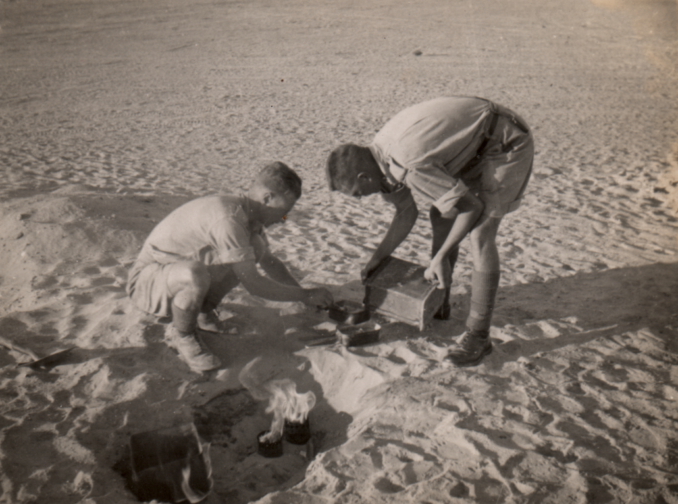
Previously unpublished photo courtesy of DJM’s uncle David, © 2021
We reach October 80 years ago and it is still fairly quiet on the ground in North Africa but the Royal Navy is still busy. The big news this month is that there is a new PM in Australia, John Curtin, and he wants the Australian troops in Tobruk withdrawn much to Churchill’s displeasure. The troops in Tobruk were mainly Australian and probably Curtin wondered why his troops were taking so much punishment.
Over a period of 10 days, cruiser-minelayers Abdiel and Latona transported replacement troops and supplies to besieged Tobruk and carried out Australian units. On the final mission Latona was bombed and sunk north of Bardia by Stuka dive bombers.
Colonel Dudley Clarke, head of deception in North Africa blotted his copy book this month. He had travelled to London to push for deception to be included from day 1 in any planning. He got his way and the London Clearing Service was created. He stopped off in Spain on his way back where he ended up being arrested for wearing women’s clothing. We quickly managed to get him back in Gibraltar where it was decided he would return to London to answer for himself. The boat he was shipped off in was sunk by a U-Boat and he was rescued and landed in Gibraltar again. Now the Governor of Gibraltar quizzed him about his fiasco and sent him back to Alexandria with a flea in his ear. Dudley seemed to have a bit of a fetish about women’s clothing but even though he never married he was not thought to bat for the other side. The novelist Dennis Wheatley was one of the recruits for the LCS, a man with a puffin like taste for alcohol. Clarke was offered command of the LCS but he preferred to remain a big fish in the North African pond rather than a small fish in London.
One Puffin asked that I keep an eye out for Lieutenant General Francis Tuker and this is the first mention I find. On the 1st of this month Francis was made the commanding officer of the Indian 34th Infantry Division as acting Major General. He would move to the Western Desert a few months later.
On the 10th near Crete good old HMS Thunderbolt was busy again sinking the Italian ship Citta di Simi. The Thunderbolt was originally launched as HMS Thetis but sank during her sea trials, of the 103 men on board only 4 survived. She was retrieved, repaired and re-christened as Thunderbolt.
Back to the Mediterranean and on the 2nd submarine HMS Perseus sank German cargo ship Castellon 60 miles west of Benghazi and on the 3rd HMS Talisman sank another German ship, the Yalova near Naples though it had already been beached which begs the question, how do you sink a beached ship. On the 4th German bombers sank anti-submarine trawler HMS Whippet near Bardia. On the 5th Swordfish attacked an Italian convoy on its way to Tripoli near Misrata and sank the tanker Rialto. On the 6th German bombers attacked shipping in the Gulf of Suez, that’s the part of the Red Sea south of the Suez Canal, sinking one ship and damaging 3 others. On the 11th bombers from 830 Squadron based in Malta attacked an Italian convoy 100 miles north of Tripoli sinking two transport ships.
On the 12th in Operation Cultivate one cruiser and three destroyers left Alexandria for Tobruk. U-75 found them and attacked 35 miles east of Tobruk sinking two landing craft and killing 34 men. A much lauded German pilot, Hans-Joachim Marseille, got his 24th & 25th kills when he shot down 2 P-40s and damaged another. On the 14th U-206 sank corvette HMS Fleur de Lys near Gibraltar, 71 were killed and 3 survived to be picked up by a Spanish ship. On the 15th, to Churchill’s chagrin, the new Australian PM decided to withdraw the Aussie troops in Tobruk. The official reason was to get all Australian troops together under their own command, but there had already been differences of opinion especially about Singapore’s defence. On the 17th a cruiser and three destroyers left Alexandria for Tobruk, arriving back the following day.
Also on the 18th eleven Albacore and two Swordfish took off from HMS Ark Royal to reinforce Malta, one of the Swordish was lost en route. On the 19th HMS Gnat bombarded German artillery near Tobruk after dark. On the 20th a cruiser and three destroyers again left Alexandria for Tobruk returning the following day. To protect them in Tobruk 2 other cruisers and 2 destroyers bombarded German coastal guns near Tobruk. On the 21st U-79 hit HMS Gnat with a torpedo near Bardia, Gnat survived – being towed back to Alexandria where she was used as a stationary anti-aircraft gun platform. Cruisers HMS Aurora and HMS Penelope arrived in Malta with destroyers HMS Lance and HMS Lively. They formed a Squadron known as Force K. For reasons that are not explained, Force K always seemed to go to sea on a Saturday, its function was to attack convoys going to Tripoli from Italy. It was later expanded by the addition of Force B and became very effective creating a de facto blockade of Tripoli.
On the 20th mines that had been laid by submarine Rorqual in the Gulf of Athens sank Italian torpedo boats Aldebaran and Altair. On the 23rd 3 cruisers and 2 destroyers bombarded the Germans at Bardia in Libya and four destroyers bombarded Sollum in Egypt. On the 24th after dark one cruiser and three destroyers went from Alexandria to Tobruk and back. They carried troops and supplies to Tobruk and on the return journey, troops of the Australian 9th Division. On the 26th submarine HMS Tetrarch left Malta for Gibraltar. On the 27th Tetrarch hit an Italian mine and sank between Sicily and Tunisia, all 62 hands were lost. Finally some action on land, on the 28th Axis forces rehearsed a planned assault on Tobruk.
And in other news …. on the 1st the Italians created the so-called “M” Battalions where M stood for Mussolini, these were formed of elite troops who had distinguished themselves in battle especially the mountain Battalions; no sniggering at the back please, there were some very good troops in the Italian Army but very few good officers. On the 2nd the second Me-163 rocket powered death trap set an unofficial speed record of 623 mph. On the 3rd it was announced in the UK that the number of deaths in motor vehicle accidents had increased by 65% during the war. On the 5th US and UK naval commanders met in Singapore. On the 7th in an attempt to improve morale, Uncle Joe lifted the ban on religion. On the 11th thousands fled Moscow based on rumours of an imminent German invasion of the capital. On the 14th Germany announced that all Jews within the 1933 German borders would be deported. On the 17th German Panzers attacked at Borodino, that name rings a bell from Napoleon’s 1812 campaign, there is little new under the sun. On the 24th Georgy Zhukov took command of the Soviet central sector. On the 27th Mountbatten replaced Roger Keyes as the British Chief of Combined Operations. On the 31st a USAAF B-17 on a night-time training run flew into a restricted area and was fired on by anti aircraft guns on the British coast. With one wing on fire the crew bailed out and survived, the bomber crashed in Knodishall, between Sizewell and Saxmundham in Suffolk.
The US was still not officially involved in the war, yet; FDR’s protestations of neutrality were looking more and more like aspirations.
© well_chuffed 2021



